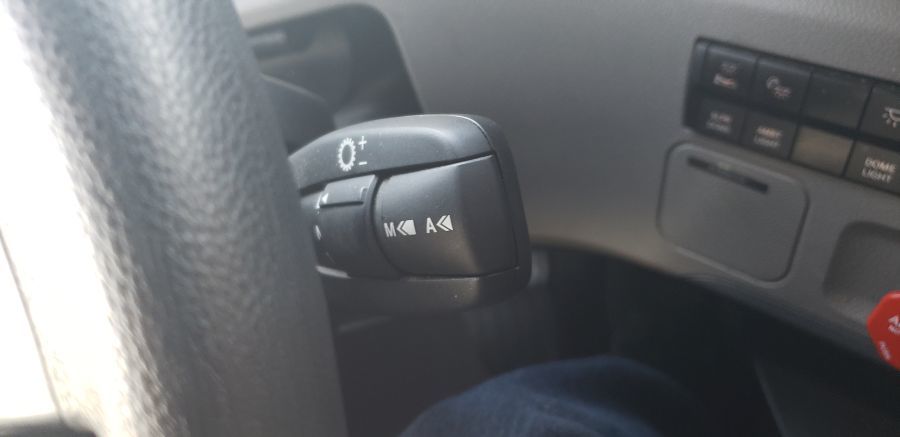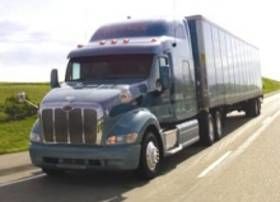Jake Brake?
Topic 26486 | Page 1
The wetter the conditions, the less you want to use the Jake brake, especially as a new driver. Experiment with it to gain a feel for the function; just don't rely on it always working. Never use it on snow or ice!
The easiest way to prevent a jackknife situation is to slow down prior to a possibly hazardous condition.
Never, ever touch those air engagement knobs while the truck is moving at any speed.
HOS:
Hours Of Service
HOS refers to the logbook hours of service regulations.Yes using the Jake in wet and slick conditions increases the chance of a jackknife. Think about what a jackknife is: the trailer is moving faster than the tractor and basically pushes the truck out of the way.
What does the Jake do? It slows the truck from the tractor back using the engine against itself. Thus slowing the tractor first and creating a situation where the trailer is going faster than the tractor. Wet conditions make it much more likely to break traction and end up jacking.
Using the service brakes to descend a grade is fairly simple. First make sure you are in the proper gear for the safe speed of decent. When you reach that speed brake until you are 5 to 10 mph below it and then let off the brakes. Rinse and repeat until you get to the bottom.
Remember prior to the late 50s trucks didn't have Jake's, but still had mountains.
OWI:
Operating While Intoxicated
These guys are right. Wet roads have less traction available. The problem with engine retarders ("Jakes") is they only work to slow down the drive axles. The other parts of your truck only slow with the brakes. So if there's a difference in traction between the axles, you're just asking for a jacknife.
Here's a principle to keep in mind on wet/slippery downhills: it's harder and even dangerous to slow down, so be careful about speeding up.
I personally play this mind game: I imagine what my maximum safe speed should be, then start out too slow. I try to manage my speed so I'm finally at my imaginary maximum speed at the bottom of the grade.
Finally, if you are going "too slow" for other trucks and they keep passing you, let 'em. First, better safe than crashed. And the time "lost" by going too slow won't add more than a minute to your total drive time. It's insignificant in the bigger scheme of things.
Yes using the Jake in wet and slick conditions increases the chance of a jackknife. Think about what a jackknife is: the trailer is moving faster than the tractor and basically pushes the truck out of the way.
What does the Jake do? It slows the truck from the tractor back using the engine against itself. Thus slowing the tractor first and creating a situation where the trailer is going faster than the tractor. Wet conditions make it much more likely to break traction and end up jacking.
Using the service brakes to descend a grade is fairly simple. First make sure you are in the proper gear for the safe speed of decent. When you reach that speed brake until you are 5 to 10 mph below it and then let off the brakes. Rinse and repeat until you get to the bottom.
Remember prior to the late 50s trucks didn't have Jake's, but still had mountains.
I am driving a 2020 Cascadia. It tries to keep the transmission in 12th, even downhill for fuel economy. Sometimes, it does downshift, but only after starting downhill, and it seems to downshift pretty hard, slowing the tractor hard. It also downshifts when using the Jake. Does the Cascadia have a manual override for downhills? Seems like your describing stab braking. Does that slow enough on steep downgrades? Any threat of overheating or loosing air pressure?
OWI:
Operating While Intoxicated
OOS:
When a violation by either a driver or company is confirmed, an out-of-service order removes either the driver or the vehicle from the roadway until the violation is corrected.
These guys are right. Wet roads have less traction available. The problem with engine retarders ("Jakes") is they only work to slow down the drive axles. The other parts of your truck only slow with the brakes. So if there's a difference in traction between the axles, you're just asking for a jacknife.
Here's a principle to keep in mind on wet/slippery downhills: it's harder and even dangerous to slow down, so be careful about speeding up.
I personally play this mind game: I imagine what my maximum safe speed should be, then start out too slow. I try to manage my speed so I'm finally at my imaginary maximum speed at the bottom of the grade.
Finally, if you are going "too slow" for other trucks and they keep passing you, let 'em. First, better safe than crashed. And the time "lost" by going too slow won't add more than a minute to your total drive time. It's insignificant in the bigger scheme of things.
I don't plan on getting in a hurry a risking not making my most important stop. I have had several trucks pass me, then get off on the next exit just a mile or two down the hwy.
Yes that is stab braking. Only way you are going to over heat your brakes or lose air is if you stay on the brakes. Stab braking allows you to use the service brakes without overheating them if you do it correctly. I run a lot of the mountains out west in the winter and have never had an issue.
Yes there is a manual option on the end of the lever to the right of the steering column. Push it in for manual.

Yes that is stab braking. Only way you are going to over heat your brakes or lose air is if you stay on the brakes. Stab braking allows you to use the service brakes without overheating them if you do it correctly. I run a lot of the mountains out west in the winter and have never had an issue.
Yes there is a manual option on the end of the lever to the right of the steering column. Push it in for manual.
Thanks Big T, I'll will try manual override and stab braking. I have been lucky so far, and haven't had to drive in a lot of rain. I should familiarize myself with the manual override and stab braking. When I go solo in a couple of weeks, there might be a chance that some early snow might occur on my route. So, I really need to get it right before I solo.

In wet conditions I am more careful about using the jake but most of the time wet conditions do not lead to jackknifing if tires are good and not about worn down. Main thing in wet or icy is be going slower before getting into tight downhill situations. Stick your auto in manual and ride down the hill in lower gear.
Something else I would suggest is taking a look inside the operating manual for any truck you are operating.
New Reply:
New! Check out our help videos for a better understanding of our forum features

















Preview:








 TT On Facebook
TT On Facebook
OK guys, we are taught not to use the Jake Brake during wet conditions because of the risk of jackknifing. Is the risk of jackknifing really that high using the Jake during wet conditions? I drive Southwest with it's many steep and long grades, and rely on the Jake for slowing the rig. I avoid using my service brake as much as possible because of the risk of overheating the brakes and loosing air pressure. In fact, I have seen four rigs burnt to the ground in the past three weeks of my mentoring, and assume brake fire as a probable cause. Also, the Jake on the Cascadia I am driven is integrated with the transmission, and the transmission downshifts during Jake use. Does the integration decrease on increase the risk of jackknifing? So, am I to avoid the Jake during wet and slick conditions? If so, and if I am to rely on the service, how do I avoid overheating? I know I could use a combination, but I would really have to use the Jake more than the service due to the steep downhills. Also, since many new rigs don't have a trailer brake, would I have to engage the trailer spring brake during a jackknife? If I use the spring brake, would I just engage it briefly, then disengage it?
OWI:
Operating While Intoxicated
OOS:
When a violation by either a driver or company is confirmed, an out-of-service order removes either the driver or the vehicle from the roadway until the violation is corrected.